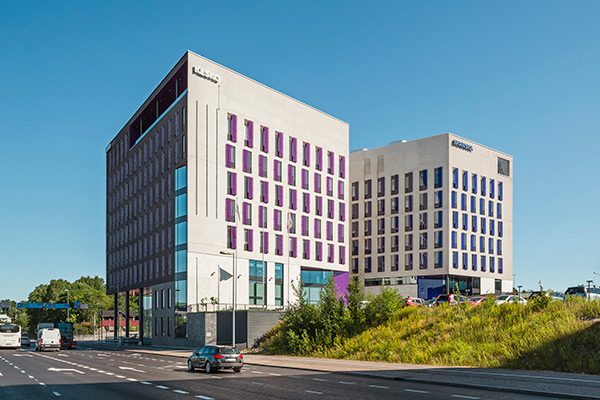

nordicum » enertec » HR viesti » kita » prointerior » prometalli » proresto » seatec »
Brains for BuildingsThe emergence of smart real estate is helping the industry reinvent itself in a big way
Photo: Kuvatoimisto Kuvio Smarter buildings are very much in demand in the real estate industry. For example, building systems – using automation rules generated from sensor data – can reduce energy and water usage considerably; cubicle utilization rates can be improved by employing occupancy sensor data to help employees find vacant cubicles; constant temperature in building zones can be achieved by taking more environmental factors into account.
Miro Ristimäki, Development Manager at Skanska, knows the challenges and opportunities in the field quite well, having written his Aalto University Doctoral Thesis on lifecycle management in urban development. “Digital tools, such as Building Information Model (BIM) concentrated, for years, in the design and planning phase, instead of adopting a more lifecycle view,” Ristimäki points out. “When the data introduced into the Building Information Model is of high quality, it can be utilized in a variety of ways. I believe that we are now in a point in time where BIM is gaining a new type of momentum.” This calls for designers, builders and end-users who have a good handle on data management and are capable of creating applications that turn senseless data into smart solutions. “The future of BIM hinges on these two things – the quality of the data involved and how easy it is to utilize.” User Comes First “Add to these two factors, the integration of the individual buildings into the surrounding community in a way that serves the everyday life of the citizens,” Ristimäki says, making a reference to the emerging Smart City solutions. A major digitalization boost will come from real estate platforms which harness different systems into a functional entity. “The platform revolution has already started and in the coming years, we will see many different types of platforms which focus on different things – for example, the degree of communication between systems and devices can vary a great deal from one platform to the next, depending on the over-all concept.” Ristimäki is also of the opinion that the most technologically advanced platform may not be the one to win the day: “The platforms that allow the creation of networks in the most effective ways are likely to be the forerunners in the race”, he predicts. Urban Power
“Only by understanding urbanization and by focusing on improvements for people can we create better buildings, better cities, and a better world,” he points out. In addition to the rapid growth in urban populations, the fast-paced technological advancements in connectivity, mobility, and computing power are changing many aspects of our lives. “The technological disruption which transforms markets and services also means a faster pace for business and new expectations for both living and working,” Voutilainen observes. “New technologies provide us with a great opportunity to ensure that buildings can serve the people who live and work in them in smarter and more exciting ways.” Voutilainen believes that in the residential building sector, for instance, we will see further pressure to embrace change, driven by two further trends: shifting demographics, and an increasing focus on social experiences.
“The former refers to the increasing number of single and small households. They have different needs, in terms of services, as well as the need to take into account an aging population and the accessibility needs of elderly residents.” Maximize Your Building “The rise in the demand for serviced housing means that residential living will have more and more in common with the hospitality sector, with people consuming more and more services – such as cleaning, home deliveries, and pet care – at home,” Voutilainen says. Apartment living has already changed a great deal in the recent years, mostly as a result of rapid technological advances. Voutilainen points out that in many homes around the world, it is not uncommon to find connected whitegoods that self-diagnose sitting alongside smart voice-controlled audiovisual systems that stream content directly from the cloud. “Then there’s the plethora of apps on smartphones and other mobile devices that we use to help us navigate everyday life,” adds Voutilainen. Roof Proof
Taking in experiences from Riga and elsewhere, in autumn 2018 Ruukki launched the second-generation version called Ruukki Roof Sensor, which is the first member of our future Sensor Network Family. Pekka Roivio, Ruukki Vice President, R&D, says that the newcomer features some significant upgrades: “The first version was all cloud-operated, but this new Smart Roof can be used also locally, making it more convenient for the users,” says Roivio. According to Roivio, Ruukki Roof Sensor means savings for facility maintenance. The system sends an alert when, for safety reasons, it’s time to remove snow from the roof; savings arise since snow does not need to be removed from the roof unnecessarily. “Today, in many places snow is often removed unnecessarily, because the weight of the snow is not known. This is a way to optimize the snow removal,” says Roivio, adding that Ruukki Roof Sensor is an especially great fit for areas of highest risk. Enter: Digital Twin In real estate, the concept of “digital twin” has been exciting imaginations for a while now – and Roivio believes that we are getting towards better and better functioning models all the time. “When we have a real-life, physical building and its exact digital twin, we can run simulations, say, 25 years in to the future, to see how a certain occurrence impacts in the long run.” Writer: Sami J. Anteroinen How did you like the article?    
|
LATEST ARTICLESNEWS |

